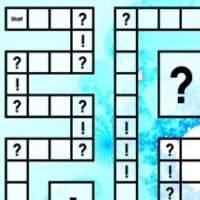By Michael Hartley
Here's a math board game with simple enough rules. A board, some 'question' cards, some 'special' cards, a die (dice), and away you go! The question cards make sure it's a learning experience for the kids who are playing, and the 'specials' make sure it's an exciting game, with the winner only known the moment they actually win! Best of all, it's all free and printable (except the die, and the playing pieces. Sorry!). For younger kids, you might start them on the Addition Board Game, which has basically the same rules, but a different set of question cards. You might also like to see a list of all the math board games on this site.
News flash! After a successful campaign on Kickstarter.com, this times tables board game is now available to buy. Dr Mike's Times Tables Game combines not just this board game, but three of the games on this site into a beautiful professionally printed package! You can still make your own free version using the downloads available on this page, of course!
To make the game, you'll need to do some printing and cutting, and maybe pasting. So, fire up your laserjet, and print out
- The Playing Board. Please note that I've given two versions of the playing board in the same file. Print out page 1 if you have a photocopier that can do enlarging. If you don't, then print out pages 2 to 5 (preferably onto card), and join the four pieces into one super-sized foldable playing board. By the way, thanks to Zazzle, you can now get the board professionally printed (at a reasonable cost). To do this, click on the image on the right.
- Choose what set of multiplication times tables questions you want to print. The easy set for younger kids, or the harder set when they've outgrown the easy set. Or hey, print out both and combine them into one massive big stack of question cards!
- Finally, print out the specials! These are what will make the game much more than just another quiz. Cut them into individual cards.
Oh, don't forget to get hold of a die and a handful of playing pieces. The playing pieces can be anything of course, buttons, coins, pieces borrowed from a monopoly or (small) chess set.
To Play, you'll need a group of 8 to 10 year olds. Each player should have one token or playing piece. Everybody places their token on the square labeled Start. Decide who goes first. Shuffle the 'question' cards, and place them on the big rectangle marked ?. Likewise, the 'special' cards go on the big rectangle marked !.
Each player then takes his or her turn around the circle as follows :

If the player is on a square marked ?, then
- An opponent draws a ? card, and asks the question printed on the card.
- The player gets one chance to answer, and must answer within 10 seconds. The question card is then returned to the pack.
- If the player fails to answer correctly within 15 seconds, they miss their turn and it is the next player's turn.
- If the player correctly answers the question, they roll the die, and move forward the number of squares indicated.
If the player is on any other square, they take their turn by rolling the die and moving the number of squares indicated.
If the player lands on a square marked !, they must draw a 'special' card and follow the instructions on it. The special card is then returned to the pack (with the exception of 'Oracle' cards, see below).
Having an Oracle Card can be helpful. An Oracle card allows the player to avoid having to answer a question. When a question is asked, a player with an Oracle card may choose to play it instead of answering. Then, it's just as if they got the answer correct! Note the following important rules about Oracle cards.
- Oracle cards are kept until played.
- Once an Oracle card is played, it is returned to the deck of special cards.
- Once a player gives a wrong answer, or exceeds the 10 seconds allowed for them to answer, it's too late for them to play their Oracle card.

The winner is the first player to land on the square marked WIN!. Note the following important rules.
- To win, a player must land exactly on the winning square
- If a player gets too high a number, they 'bounce back'. For example, if they are 2 squares away from the winning square, and roll a 6, they will move two squares forwards and then 4 squares backwards, and draw a special card.
And that's basically it! I hope your kids enjoy the game. Here's some tips you might like to try.
Make the Start square a ? square also, so a player must answer a question correctly before they can start moving.
Invent new sets of question cards to test different skills - addition, geometry ... spelling ... whatever you like!
Have your kids brainstorm and invent new specials! Oh, and do let me know the best ideas they come up with!
I know some poeple don't have time to do so much cutting and pasting, which is why I've had it on my mind for a long time to get Dr Mike's Times Tables Game for you to just buy and play. Check out the Unboxing video below:
